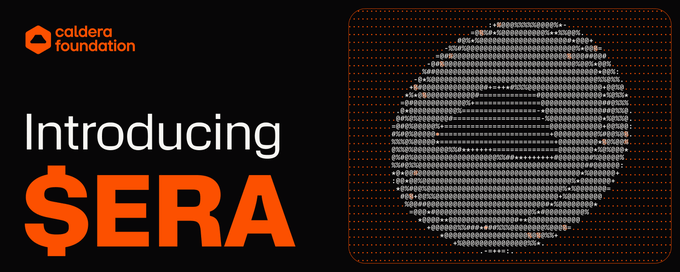Caldera: Reshaping Ethereum Ecosystem with Modular Rollup Engines
Founded in 2022 by Stanford alumni Matt Katz and Parker Jou, Caldera is revolutionizing blockchain scalability through a “Rollup-as-a-Service” (RaaS) model. The project has raised $24 million from top-tier investors including Sequoia Capital and Founders Fund, aiming to solve the core pain points developers face when building custom L2/L3 chains: traditional Rollup development requires setting up nodes, sequencers, and bridges, which is costly and time-consuming.
Caldera supports one-click deployment engines compatible with Arbitrum Nitro, OP Stack, and ZK Stack, enabling developers to launch dedicated chains within 5 minutes—significantly reducing the barrier to entry. The platform has deployed 75+ application chains across gaming, DeFi, and AI, with over $1B in total value locked (TVL), accounting for 12% of the Ethereum L2/L3 ecosystem.

This Token Insights article explores how Caldera leverages modular architecture to simplify Rollup development, covering technical principles, tokenomics, and airdrop claim process.
Technical Architecture: Four-Layer Modular Design
Caldera’s value lies in its flexible four-layer architecture, allowing developers to freely compose components based on their needs:
-
Execution Layer: Supports EVM/SVM/FuelVM and custom gas tokens, handling transactions and smart contract logic.
-
Settlement Layer: Verifies proofs on base chains like Ethereum and Polygon, inheriting their security.
-
Data Availability Layer (DA): Offers Ethereum, Celestia, and EigenDA as options, with Celestia reducing storage costs by 90%.
-
Interoperability Layer (Metalayer): Enables abstracted cross-chain communication, completing asset transfers in under 2 seconds without bridges.
This architecture delivers over 20,000 TPS per chain and transaction costs as low as $0.001 (1/100th of Ethereum L1), ideal for high-frequency applications. Developers can refer to JuCoin’s developer guide for integration details.
Token Economics: Dual Utility of $ERA
The $ERA token is the core utility of the ecosystem, with a fixed supply of 1 billion tokens. Its distribution strategy balances community incentives and long-term development:
-
30% for airdrops: Pre-claim began on July 11, 2025, with early testnet users prioritized.
-
25% for ecosystem incentives: Includes liquidity mining and node subsidies.
-
20% for team and advisors: 12-month lockup followed by 4-year vesting.
-
Remainder: Investors (15%) and foundation reserve (10%).
$ERA powers three primary use cases:
-
Gas Payments: Fuel for cross-chain transactions.
-
Network Security: 8-15% staking APR to ensure node reliability.
-
Governance Voting: Determines tech upgrades and fund allocation.
Ecosystem Growth & Partnerships
Caldera’s partnership network spans three major domains:
-
Gaming: ApeChain (Yuga Universe chain) and HYchain (raised $8M in node sales in the first month) use Caldera’s framework.
-
DeFi: Compliance-focused KINTO and oracle provider OEV Network deploy custom Rollups.
-
Infrastructure: Celestia provides low-cost DA; Pyth Network supplies real-time oracles; EigenLayer supports restaking security.
Key growth metrics include:
-
Over 17 million unique wallet addresses
-
40% of new Q2 2025 chains are AI-focused (e.g., ClusterProtocol)
-
Over 860,000 daily transactions
Airdrop Claim Process & Warnings
Community pre-claims started July 11, 2025. Users active before February 2025 (testnet deployers, Guardian node holders, cross-chain users) can verify on-chain records to claim airdrops. Binance Alpha’s exclusive channel opens July 17 in two phases:
-
First 18 hours: 1,875 ERA per 224 points
-
Final 6 hours: 1,875 ERA per 140 points
Cautions:
-
Non-pre-claimers may earn airdrops via mainnet staking, but allocations may decrease.
-
The official team warns ERA is not yet in circulation—beware of fake tokens.
Competitive Landscape & Core Challenges
In the RaaS sector, Caldera faces differentiated competition: AltLayer uses a rollup aggregation model but lacks full framework support; Conduit is tied to the Coinbase ecosystem, limiting flexibility. Caldera’s all-framework compatibility (OP/ZK/Arb) is its key moat, reflected in its $400M valuation. However, three core risks remain:
-
Metalayer’s cross-chain messaging hasn’t been tested at scale.
-
The SEC may classify staking features as securities issuance.
-
Only 35% TVL retention rate on new chains—needs better ecosystem stickiness.
JuCoin’s RaaS industry analysis notes that modularization is the prevailing trend, but projects must prove their long-term value capture.
When developers are no longer burdened by node configuration, and gaming studios can focus on gameplay rather than gas optimization, blockchain scalability reaches true democratization. Caldera’s mission is not just a technical upgrade—it’s a real-world test of whether modularity can become the ultimate scaling solution. Its success or failure will define the infrastructure standard for the next generation of Web3 applications.





